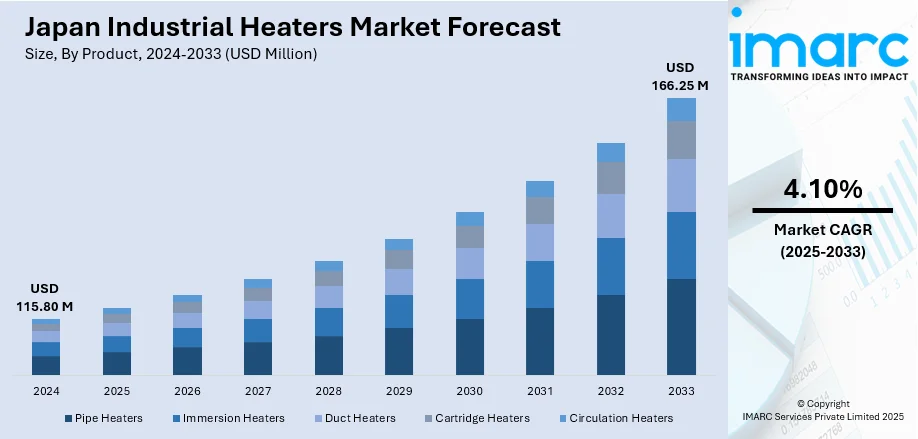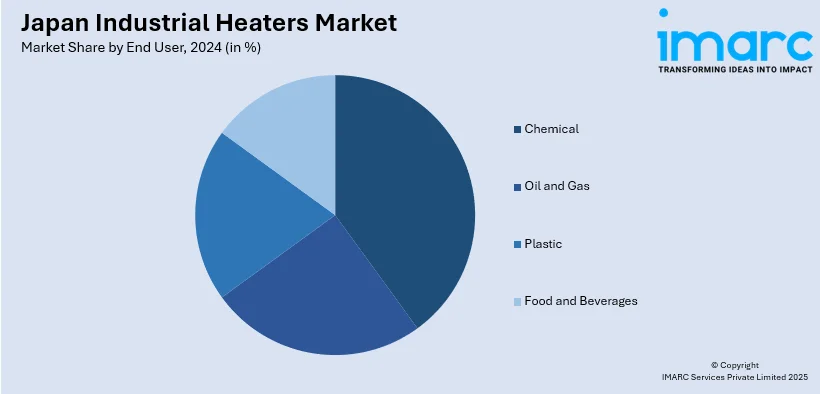
Japan Industrial Heaters Market Size, Share, Trends and Forecast by Product, Technology, End User, and Region, 2025-2033
Japan Industrial Heaters Market Overview:
The Japan industrial heaters market size reached USD 115.80 Million in 2024. Looking forward, IMARC Group expects the market to reach USD 166.25 Million by 2033, exhibiting a growth rate (CAGR) of 4.10% during 2025-2033. The rising labor costs and a shrinking workforce are encouraging companies to adopt automated heating systems, enhancing efficiency and reducing reliance on manual labor in production processes. Additionally, the growth of semiconductor and electronics industries, which require accurate temperature regulation, is contributing to the expansion of the Japan industrial heaters market share.
|
Report Attribute
|
Key Statistics
|
|---|---|
|
Base Year
|
2024 |
|
Forecast Years
|
2025-2033
|
|
Historical Years
|
2019-2024
|
| Market Size in 2024 | USD 115.80 Million |
| Market Forecast in 2033 | USD 166.25 Million |
| Market Growth Rate 2025-2033 | 4.10% |
Japan Industrial Heaters Market Trends:
Growth of Semiconductor and Electronics Industry
The robust semiconductor and electronics sectors in Japan are driving the need for highly specialized industrial heaters. In these industries, accurate temperature regulation is crucial for manufacturing top-quality electronic parts. Industrial heaters play a vital role in operations such as wafer fabrication, component soldering, and thermal treatment of materials utilized in electronics. With the growing demand for advanced electronics, ranging from electric vehicles (EVs) to consumer electronics and industrial automation, the necessity for dependable and precise heating solutions is rising. Businesses are concentrating on creating heating systems that can sustain consistent temperatures with minimal variations to protect the quality of sensitive parts. A prime illustration of this demand is seen in the expansion of Japan's electronics sector. As reported by the Japan Electronics and Information Technology Industries Association (JEITA), the overall production value of Japan's electronics industry reached 928,941 million yen in February 2025, with an annual total for 2025 expected to reach 1,788,254 million yen. This increase highlights the growing need for accurate heating technologies for adapting to the rapidly changing electronics market. As a result, there is a rise in the need for industrial heaters specifically engineered to facilitate high-precision manufacturing processes, signifying an important evolution in Japan's industrial heater market as it addresses the unique requirements of the electronics industry.

To get more information on this market, Request Sample
Rising Labor Costs and Need for Automation
With labor expenses increasing in Japan, firms are progressively investing in industrial heaters that provide greater automation and need less manual involvement. By integrating automated systems into their operations, companies can decrease their dependence on labor, optimize processes, and considerably cut overhead expenses. These automated heating systems are fitted with sophisticated control features that guarantee accurate temperature regulation without requiring continuous oversight, improving efficiency and reliability. Automation holds a vital importance in sectors like automotive and electronics, where accuracy is essential. Moreover, automation guarantees that processes stay uniform, which is crucial for upholding high-quality standards. The movement towards automation is increasingly urgent as Japan encounters a notable demographic change. In 2024, Japan's elderly demographic reached 36.25 million, with individuals aged 65 and above comprising almost one-third of the overall population. This demographic change is leading to a diminishing workforce and rising labor expenses, prompting industries to pursue automation-based solutions. As a result, the need for industrial heaters that enhance operations, lessen reliance on labor, and boost productivity is increasing. These elements are supporting the Japan industrial heaters market growth, as companies adjust to labor shortages and the demand for enhanced operational efficiency.
Japan Industrial Heaters Market Segmentation:
IMARC Group provides an analysis of the key trends in each segment of the market, along with forecasts at the country and regional levels for 2025-2033. Our report has categorized the market based on product, technology, and end user.
Product Insights:
- Pipe Heaters
- Immersion Heaters
- Duct Heaters
- Cartridge Heaters
- Circulation Heaters
The report has provided a detailed breakup and analysis of the market based on the product. This includes pipe heaters, immersion heaters, duct heaters, cartridge heaters, and circulation heaters.
Technology Insights:
- Electric Based
- Steam Based
- Hybrid Based
A detailed breakup and analysis of the market based on the technology have also been provided in the report. This includes electric based, steam based, and hybrid based.
End User Insights:

- Chemical
- Oil and Gas
- Plastic
- Food and Beverages
The report has provided a detailed breakup and analysis of the market based on the end user. This includes chemical, oil and gas, plastic, and food and beverages.
Regional Insights:
- Kanto Region
- Kansai/Kinki Region
- Central/ Chubu Region
- Kyushu-Okinawa Region
- Tohoku Region
- Chugoku Region
- Hokkaido Region
- Shikoku Region
The report has also provided a comprehensive analysis of all the major regional markets, which include Kanto Region, Kansai/Kinki Region, Central/ Chubu Region, Kyushu-Okinawa Region, Tohoku Region, Chugoku Region, Hokkaido Region, and Shikoku Region.
Competitive Landscape:
The market research report has also provided a comprehensive analysis of the competitive landscape. Competitive analysis such as market structure, key player positioning, top winning strategies, competitive dashboard, and company evaluation quadrant has been covered in the report. Also, detailed profiles of all major companies have been provided.
Japan Industrial Heaters Market News:
- In May 2024, Alleima announced a SEK 100 million investment to expand its Industrial Heating production capacity in Sakura, Japan. The new facility, part of the Kanthal division, would increase capacity by about 60% to meet growing demand in Asia. This move supported the shift from fossil fuel to electric heating in industries like steel and automotive.
Japan Industrial Heaters Market Report Coverage:
| Report Features | Details |
|---|---|
| Base Year of the Analysis | 2024 |
| Historical Period | 2019-2024 |
| Forecast Period | 2025-2033 |
| Units | Million USD |
| Scope of the Report |
Exploration of Historical Trends and Market Outlook, Industry Catalysts and Challenges, Segment-Wise Historical and Future Market Assessment:
|
| Products Covered | Pipe Heaters, Immersion Heaters, Duct Heater, Cartridge Heaters, Circulation Heaters |
| Technologies Covered | Electric Based, Steam-Based, Hybrid Based |
| End Users Covered | Chemical, Oil and Gas, Plastic, Food and Beverages |
| Regions Covered | Kanto Region, Kansai/Kinki Region, Central/ Chubu Region, Kyushu-Okinawa Region, Tohoku Region, Chugoku Region, Hokkaido Region, Shikoku Region |
| Customization Scope | 10% Free Customization |
| Post-Sale Analyst Support | 10-12 Weeks |
| Delivery Format | PDF and Excel through Email (We can also provide the editable version of the report in PPT/Word format on special request) |
Key Questions Answered in This Report:
- How has the Japan industrial heaters market performed so far and how will it perform in the coming years?
- What is the breakup of the Japan industrial heaters market on the basis of product?
- What is the breakup of the Japan industrial heaters market on the basis of technology?
- What is the breakup of the Japan industrial heaters market on the basis of end user?
- What is the breakup of the Japan industrial heaters market on the basis of region?
- What are the various stages in the value chain of the Japan industrial heaters market?
- What are the key driving factors and challenges in the Japan industrial heaters market?
- What is the structure of the Japan industrial heaters market and who are the key players?
- What is the degree of competition in the Japan industrial heaters market?
Key Benefits for Stakeholders:
- IMARC’s industry report offers a comprehensive quantitative analysis of various market segments, historical and current market trends, market forecasts, and dynamics of the Japan industrial heaters market from 2019-2033.
- The research report provides the latest information on the market drivers, challenges, and opportunities in the Japan industrial heaters market.
- Porter's five forces analysis assist stakeholders in assessing the impact of new entrants, competitive rivalry, supplier power, buyer power, and the threat of substitution. It helps stakeholders to analyze the level of competition within the Japan industrial heaters industry and its attractiveness.
- Competitive landscape allows stakeholders to understand their competitive environment and provides an insight into the current positions of key players in the market.
Need more help?
- Speak to our experienced analysts for insights on the current market scenarios.
- Include additional segments and countries to customize the report as per your requirement.
- Gain an unparalleled competitive advantage in your domain by understanding how to utilize the report and positively impacting your operations and revenue.
- For further assistance, please connect with our analysts.
 Request Customization
Request Customization
 Speak to an Analyst
Speak to an Analyst
 Request Brochure
Request Brochure
 Inquire Before Buying
Inquire Before Buying




.webp)




.webp)












